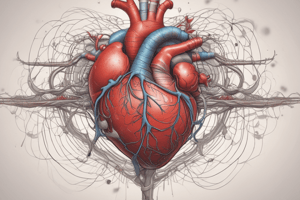Podcast
Questions and Answers
What is the average cardiac output at rest?
What is the average cardiac output at rest?
- 15-20 L/min
- 10-12 L/min
- 5-6 L/min (correct)
- 1-2 L/min
Which part of the nervous system is involved in short-term blood pressure regulation?
Which part of the nervous system is involved in short-term blood pressure regulation?
- Cerebral cortex
- Enteric nervous system
- Autonomic nervous system (correct)
- Somatic nervous system
What is the primary function of the pulmonary circulation?
What is the primary function of the pulmonary circulation?
- Deoxygenated blood to the heart and oxygenated blood to the body
- Carbon dioxide removal from the body
- Deoxygenated blood to the lungs and oxygenated blood to the heart (correct)
- Oxygen delivery to the body
Which type of muscle is characterized by involuntary, non-striated, and single-nucleated fibers?
Which type of muscle is characterized by involuntary, non-striated, and single-nucleated fibers?
What is the primary function of the medulla oblongata in breathing regulation?
What is the primary function of the medulla oblongata in breathing regulation?
What is the term for the functional unit of the kidney?
What is the term for the functional unit of the kidney?
What is the primary function of antidiuretic hormone (ADH) in urine formation?
What is the primary function of antidiuretic hormone (ADH) in urine formation?
What is the term for the strengthening or weakening of synaptic connections between neurons?
What is the term for the strengthening or weakening of synaptic connections between neurons?
What is the term for the rhythmic contractions and relaxations of the digestive system?
What is the term for the rhythmic contractions and relaxations of the digestive system?
What is the primary function of the dendrites in a neuron?
What is the primary function of the dendrites in a neuron?
Flashcards are hidden until you start studying
Study Notes
Cardiovascular Physiology
- Heart Function:
- Beats around 100,000 times per day
- Pumps approximately 2,000 gallons of blood daily
- Cardiac output: 5-6 L/min at rest, up to 20-30 L/min during exercise
- Blood Pressure Regulation:
- Short-term regulation: baroreceptors, vasomotor center, and autonomic nervous system
- Long-term regulation: renal system and hormonal control
- Blood Circulation:
- Pulmonary circulation: deoxygenated blood to lungs, oxygenated blood to heart
- Systemic circulation: oxygenated blood to body, deoxygenated blood to heart
Respiratory Physiology
- Gas Exchange:
- External respiration: oxygen in, carbon dioxide out
- Internal respiration: cellular respiration, energy production
- Breathing Regulation:
- Voluntary control: diaphragm and intercostal muscles
- Involuntary control: medulla oblongata, pons, and pneumotaxic center
- Respiratory System Functions:
- Oxygen delivery to cells
- Carbon dioxide removal
- pH regulation
Muscle Physiology
- Muscle Types:
- Skeletal muscles: voluntary, striated, and multinucleated
- Smooth muscles: involuntary, non-striated, and single-nucleated
- Cardiac muscles: involuntary, striated, and single-nucleated
- Muscle Contraction:
- Excitation-contraction coupling: neural stimulation, calcium release, and muscle contraction
- Sliding filament theory: actin and myosin interaction
Renal Physiology
- Kidney Functions:
- Filtration: glomerular filtration rate (GFR), around 125 mL/min
- Reabsorption: selective reabsorption of essential nutrients and ions
- Secretion: waste removal and hormonal regulation
- Urine Formation:
- Nephron: functional unit of the kidney
- Urine concentration: regulated by antidiuretic hormone (ADH) and aldosterone
Neurophysiology
- Neuron Structure:
- Dendrites: receive signals
- Cell body: integrates signals
- Axon: transmits signals
- Terminal buttons: release neurotransmitters
- Neurotransmission:
- Synaptic transmission: chemical signaling between neurons
- Synaptic plasticity: strengthening or weakening of synaptic connections
Digestive Physiology
- Digestive System Functions:
- Ingestion: food intake
- Mechanical digestion: chewing and grinding
- Chemical digestion: enzymatic breakdown of nutrients
- Gut Motility:
- Peristalsis: rhythmic contractions and relaxations
- Gastric motility: mixing and churning of food
- Nutrient Absorption:
- Carbohydrates: broken down into simple sugars
- Proteins: broken down into amino acids
- Fats: broken down into fatty acids and glycerol
Cardiovascular Physiology
- Heart beats approximately 100,000 times daily and pumps around 2,000 gallons of blood
- Cardiac output is 5-6 L/min at rest and up to 20-30 L/min during exercise
- Heart function is regulated by short-term mechanisms (baroreceptors, vasomotor center, and autonomic nervous system) and long-term mechanisms (renal system and hormonal control)
Respiratory Physiology
- Gas exchange involves external respiration (oxygen in, carbon dioxide out) and internal respiration (cellular respiration and energy production)
- Breathing is regulated by voluntary control (diaphragm and intercostal muscles) and involuntary control (medulla oblongata, pons, and pneumotaxic center)
- Respiratory system functions include oxygen delivery to cells, carbon dioxide removal, and pH regulation
Muscle Physiology
- Skeletal muscles are voluntary, striated, and multinucleated, whereas smooth muscles are involuntary, non-striated, and single-nucleated
- Cardiac muscles are involuntary, striated, and single-nucleated
- Muscle contraction involves excitation-contraction coupling (neural stimulation, calcium release, and muscle contraction) and the sliding filament theory (actin and myosin interaction)
Renal Physiology
- Kidney functions include filtration (glomerular filtration rate around 125 mL/min), reabsorption of essential nutrients and ions, and secretion of waste and hormonal regulation
- Urine formation involves the nephron (functional unit of the kidney) and is regulated by antidiuretic hormone (ADH) and aldosterone
- Urine concentration is regulated by ADH and aldosterone
Neurophysiology
- Neuron structure consists of dendrites (receive signals), cell body (integrates signals), axon (transmits signals), and terminal buttons (release neurotransmitters)
- Neurotransmission involves synaptic transmission (chemical signaling between neurons) and synaptic plasticity (strengthening or weakening of synaptic connections)
Digestive Physiology
- Digestive system functions include ingestion, mechanical digestion (chewing and grinding), and chemical digestion (enzymatic breakdown of nutrients)
- Gut motility involves peristalsis (rhythmic contractions and relaxations) and gastric motility (mixing and churning of food)
- Nutrient absorption involves the breakdown of carbohydrates into simple sugars, proteins into amino acids, and fats into fatty acids and glycerol
Studying That Suits You
Use AI to generate personalized quizzes and flashcards to suit your learning preferences.




